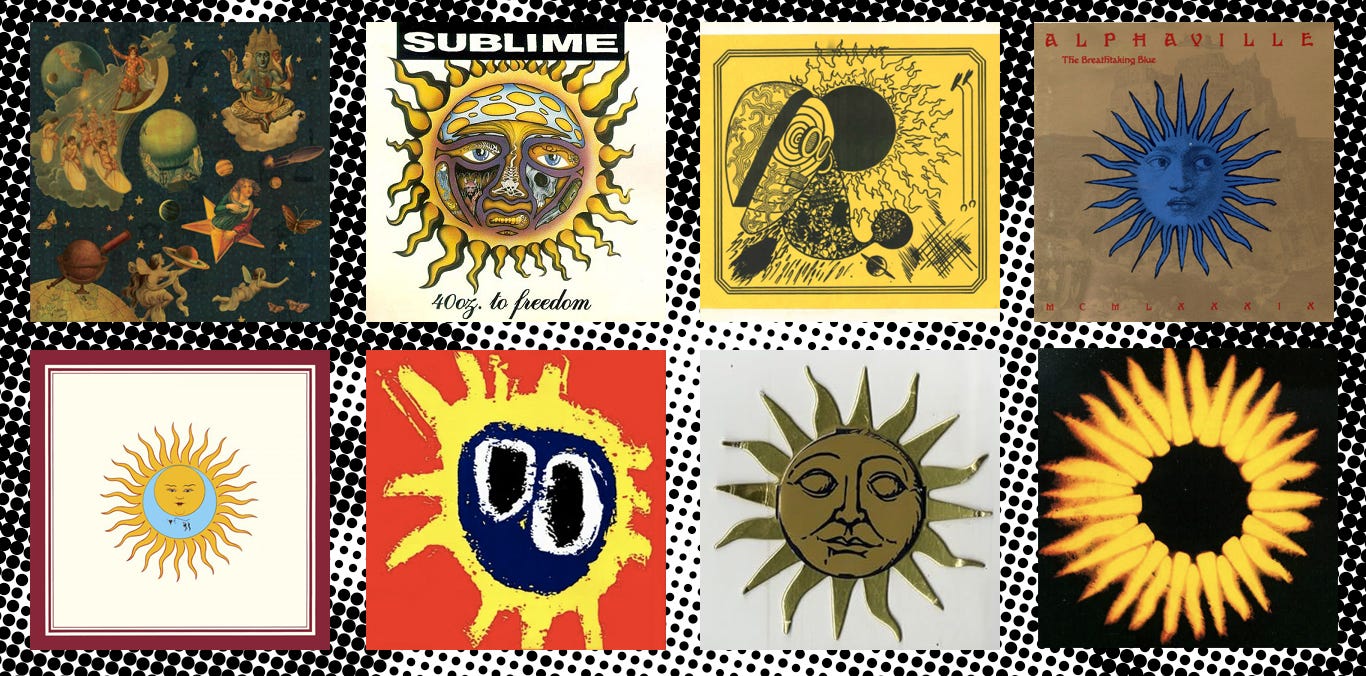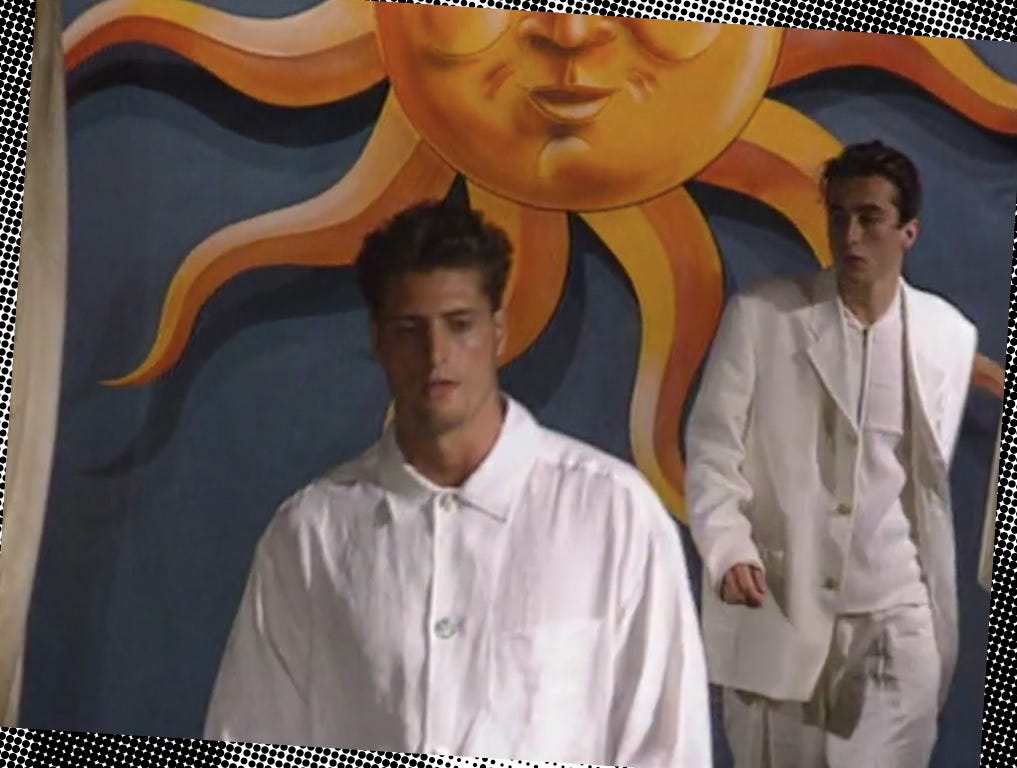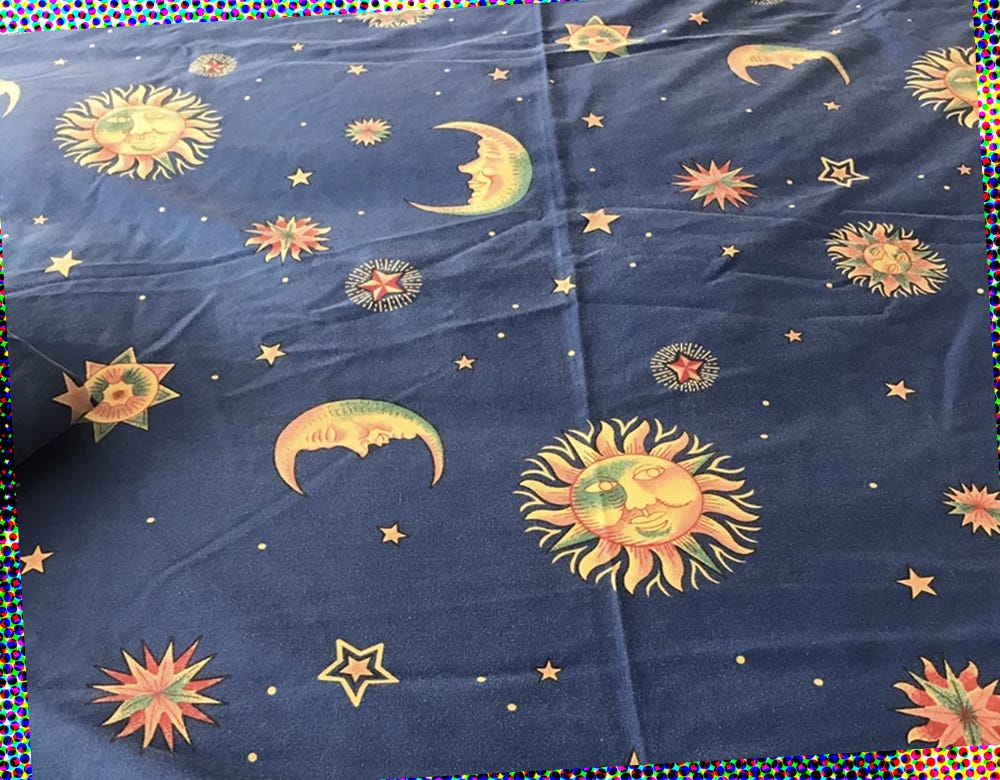Celestial expansion and cultural recline
Collective memory, pattern proliferation and how Baleriac LSD begot suburban bedding.
Crust is a weekly newsletter on taste and culture from Tāmaki Makaurau.
Mōrena, today I want to talk about old duvets and new mediums of communication. You’ll also find New Zealand Fashion Week updates (including when to expect the schedule announcement), the album I’ve been playing all week, stray thoughts on the coding of writing conventions and floral dresses, plus magazine news and an idea for Vogue Australia.
I spent Friday night on the couch watching old Dries Van Noten shows (as one does) from the early 1990s, an era of smiling models and charming mugging for the camera, and clothes that make contemporary menswear look both lazy and uptight. And then I saw it, a sun, that sun, hanging in the back of the runway, earnestly rendered like a community theatre set. It’s the one from your childhood duvet cover.
The motif is a totemic thing for members of several generations, all of whom are likely familiar with that bedding (you know which). For my demographic — elder Millennials — they’re now imbued with naïveté and innocence, but at the time, they seemed so worldly, so sophisticated. Owning one felt like a first step on the road to a life that would include velvet clothes, expert kohl application, travel and a loft apartment to come back to. Chic.
It went well with Enigma, Enya and Madonna’s Ray of Light era. And, judging by my DMs after posting an Instagram story about it last weekend, everyone had one. Most recall theirs being bought from Farmers, while one lucky person I spoke to had multiple iterations, from Briscoes, Harvey Norman and The Warehouse. I grew up in Australia and had one too, from Myer or Spotlight (Mum can’t remember which). Meanwhile, across the Pacific Ocean, North Americans were apparently buying theirs from the likes of Hanes, Haywin, Sears and Highland Feather.
They were the hot thing. Culturally, the Anglosphere was in the throes of a renewed fascination with “The East” (including fashion) and alternative ideologies and practices — astrology, yoga, chai lattes, incense — and “witchy” stuff like tarot, sage and brunettes; Charmed started in 1998, the same year Practical Magic hit cinemas, and both were predated by Buffy a year earlier.
Also at play, the distribution and logistics behind a duvet covered in astronomical motifs becoming a sprawling international phenomenon. Its rise married with a period of growing globalisation, as well as shifts in manufacturing, retail and distribution.
The fact that the pattern, that familiar celestial motif — so mystical and folkoric — pulls from the past adds to the powerful nostalgia we feel for this stuff now. We remember it, but it’s kind of gone too. They live on in digital ephemera and (if you’re lucky) your mum’s linen cupboard.
Over a quarter of a century later, the decor forms a communal touchstone (and many Reddit threads, particularly in the plaintive r/HelpMeFind sub). Looking back at all of them is a little uncanny; each iteration slightly different, but with enough in common to have the effect of a spot-the-difference puzzle, or all those French children dressed as Serge Gainsbourg.
Existing as they did before the widespread adoption of participatory internet but recently enough to be captured in the dragnet of resale sites, Pinterest and forums, they remain a kind of liminal ephemera, something we forget about until memories are jogged unexpectedly.
Let’s zoom in on those cheerful, often anthropomorphic, suns a little though, since that’s what started this week’s newsletter. In New Zealand, the motif was in circulation in the 1980s; a poster for Strange Devices has a sun, so does one for an Abel Tasmans gig; both were at Rising Sun on Karangahape Road, so that makes sense. More abstract, though still relevant, I think, is the winning entry of the 1990 Nationwide Quiltmaking Competition was “Putanga ote Ra (Birth of the Sun)” by Gwen Wanigasekera. Across the ditch, it even enjoyed the hallowed territory of a Mambo shirt.
The Dries Van Noten show that caught my eye was from 1992, and while talking about it to a fashion-y friend about which came first, the Dries or The Duvet, they wondered where Mellon Collie and the Infinite Sadness, The Smashing Pumpkins’ 1995 album, sat on the timeline. A little late in fact, if we’re to focus on album covers. Primal Scream’s Screamadelica — which defined a genre and era thanks to Paul Cannell’s trippy, childlike sun — came out in 1991, and Sublime’s even trippier iteration followed in 1992. Earlier still was Tears for Fears’ 1989 album The Seeds of Love, and well before all of that was King Crimson’s Larks’ Tongues in Aspic, and the Afrofuturism of Sun Ra and Saturn Label (there’s a whole book on it if you’re keen).

All of it is drawing from an ancient motif. Heraldry goes hard for a sun. So did alchemists, Huichol art and Kashani potters. The Inca worshipped sun god Inti, and their representations gave him a face. Helois had one too. Solar symbols go way, way back all around the world, and we’ve all looked up at the same sun since we were tagging on cave walls.
But let’s return to the 1990s. The “Second Summer of Love” dawned in 1989, and the years that followed saw a revival of the 1960s and 1970s. Heliocentrism found a home in the sun worship of backpacking culture (sorry, “travellers”). In fashion, woo-woo and globetrotting iconography abounded; the Jean Paul Gaultier Soleil line even had a sun in its logo. By the end of the decade, space and futurism were in the mix too, helped by Hollywood and the looming precipice of the new millennium, so it’s no surprise that this all had filtered down to the manchester section at your local homeware store and everyone going mad for celestial prints. Baleriac LSD begot suburban bedding.
It might have been everywhere, but at least it wasn’t dull. (I’m so bored with all the plain linen bedspreads of the 2020s.) Back then, bedrooms weren’t displayed for public witness quite the way they are now; they were generally reserved for family, friends and lovers, and even if you took a photo of your bed — and why would you? — it wouldn’t go far.
Depending on your age at the time, above it were probably glow-in-the-dark stars adorning the ceiling, next to the fly poo, and if you were really, really cool, you had a lava lamp (I told you, it was an age of revival) to complement your celestial bedding.
Appreciation of this particular cultural relic continues, and rather miraculously, it hasn’t really been relegated to the sphere of bad tastes, nor does it appear to be experiencing an ironic revival (though Temu does sell some, which I will certainly not be linking to).
While canonically “New Age” and “old world”, in the contemporary taxonomy of the brilliant CARI, we’d shelve these in Whimsigoth, Global Village Coffee House (both credited to Evan Collins, co-founder of the platform) and Nouveau Organic, while online compatriots Aesthetics Wiki would place them in Spacecore (obviously), FantasY2K and even Utopian Scholastic (originally) categorised by Suze Huldt.)
This enduring appeal also gives pause, as we consider the recent aesthetic revivalism shaping much of online media’s output (“establishment” and user generated), more often than not rooted in nostalgia for the 1990s. Vice argued for Enyacore, Y2K home decor, and fashion’s medieval revival in 2023 in a trilogy of stories that can be viewed on Wayback Machine because so much internet writing is just dead links now; a year prior Architectural Digest identified a veritible Renaissance Faire renaissance in interior design, declaring “Middle Ages Modern” as a “new aesthetic for our increasingly Medieval times”.
Little did they know things were going to get way more feudal. Squint and we can see the topography of a new era of mysticism and spirituality, and that ancient desire for meaning and belonging is manifesting across all aspects of culture: fandom, crypto, and the (moral panic?) of A.I worship and digitalism. It’s there in the horoscope apps and growing fluency of luteal phases.
Communication itself is shifting toward forms that may reactivate animistic patterns of thinking. The excellent Katherine Dee has been calling it “techno-animism” and talks to ecologist Andrey Mir, who argues that the Internet fosters “digital orality,” fundamentally restructuring how we communicate in ways that echo (though don't replicate) pre-literate oral cultures. While much discussion focuses on how this affects politics and education, I wonder if it's also making us more receptive to contemporary sages.
Digitalism and the Space Race 2.0 are themselves a kind of spirituality — this belief in exploration, terraforming and transhumanism. And back on earth, there’s a much-documented cohort choosing a different creed: rotting. (How much of this is performed aesthetisation, rather than a real-life practice and way of life, I’ll leave to others to question.)
Which brings us back to bed, and what’s above it. Staring up at the night sky, we commune around the Matariki star cluster and marvel at the “rare” lunar events (which happen with eyebrow-raising frequency).
We commune too around relics of past lives. Like that bedding. Unlike more divisive items of decor, there’s a universality (lol) to our fondness for this. We all had one. And it’s something we all seem to agree on.
Do you know what else is a celestial vision? The ceiling of the Civic Theatre. It’s playing host to a range of films at Whānau Mārama: New Zealand International Film Festival this August, so are some of Tāmaki Makaurau’s best theatres, including The Academy, Hollywood Avondale and The Lido. The schedule is very good, and though last week I promised to share my picks with you today, this newsletter is already far too long (for email) so let’s do that next Friday…
Listening… to Orbits, the new album from The Circling Sun. It’s very lovely, space-y and jazzy. And fitting given the theme of this newsletter, which also extended to some of the songs I played on bFM’s Morning Glory show yesterday, including ‘Movin’ on Up’ by Primal Scream, Frank Ocean’s ‘Moon River’ (the best version), ‘Forget That Lamp, Bring the Sun’ by Patio — more on that last artist and other great “IDM” electronica can be found in
’s great Audioculture story from earlier this month.Following… the waves of announcements around New Zealand Fashion Week, and it feels like momentum is building. The official schedule will be announced on Monday July 21, but this week saw a few early announcements of show dates; Harris Tapper confirmed an intimate show at Blue, a freshman outing that will host “less than 100 guests” as Tyson Beckett explains; around the corner (is Ponsonby proving an early trend for off-site shows?) at Goblin bar, The Keep will thold a “Fashion Parade” (parade!!!) featuring designers Lela Jacobs, Wilbur Hsu and Outerlines, with jewellery from Orswo, Annabella Schnabel and Shannen Young. Another group show, Kiri Nathan’s Kāhui Collective, has confirmed its designer lineup: Mitchell Vincent Collection, Nichola Te Kiri (NTKMADE LTD), Jacob Tamehana Coutie (J’AKE) and Temesia Tuicaumia (Temesia Co). Tickets for that and other events (including the must-see retrospective) are available to the public, though Juliette Hogan has sold out already. In other news, more partners have come on board, including another big one, DHL, which will present the Future of Fashion Showcase of emerging talent.
Watching… Too Much. I like it (so far) but could do without the Austen-era fantasy sequences.
Reading… about whether floral dresses are politically coded (for what it’s worth, I think, as with everything, it’s all about context and intent and you should wear what you like) and whether typing conventions signal a certain kind of femininity. Between the accusations of em dash synthetic/fraud and the subtext behind capitalisation, I don’t think we’ve seen so much attention paid to case and punctuation style since we all tYpEd LiKe ThIs. Seriously though, this is fascinating and unsurprising, and we’re only going to see more rebellion through the written word as people demonstrate proof of life, and creativity of form is something to be excited about.
Thinking… That the newsworthy-ness of a business re-signing its CBD lease for another 25 years says a lot about the state of retail. Good on Crane Brothers for doing it. The lovely Tom Raynel has intel on why Murray Crane remains committed to High Street, somewhere that, when I spoke to him earlier this year for Viva, he clearly has a lot of love for. Crane told Tom that “tenancies are being refilled and leases signed and people are looking for space”, and as someone who’s in the city every day, I agree; it’s busier and buzzier than it’s been in years. The Strand Arcade activations have been great (I experienced it first hand), and more of this around the city will go a long way. The future for retail — and everything — in town is niche, bespoke and focused, catering to a discernible clientele and offering experiences that you’d be willing to leave your house for. There’s no better way to shop than in person, and schlepping somewhere for food makes it taste better.
Rat World has a new issue? The magazine looks great, and they’re throwing a launch event on Saturday night at Rumours. I love indie media.
There’s a mysterious, ancient pool in northern France that has seen three divers die trying to find its source? It’s called Fosse Dionne and it’s in the small town of Tonnerre.
The hunt is on for the best chocolate mousse in Aotearoa? It’s my favourite dessert, so I was delighted to read that news in the last week's edition of Metro’s Pot Luck.
Amy Taylor is on the cover of Vogue Portugal? It looks great. The fact that she hasn’t had the same treatment from the Aussie edition yet mystifies me. Imagine the possibilities! I’m seeing Mad Max and Welcome to Woop Woop, golden tans and schooners, and of course bikinis. It would be perfect for a summer issue…
Twenty-seven Names is having an archive sale? It’s happening this weekend, Friday to Sunday, at their stores in Tāmaki Makaurau and Auckland and Pōneke.
You can read all of the Graydon Carter-era Spy magazines online? And they’re free! It’s essential intel from an essential interview with Michael M. Grynbaum on
’s Feed Me. His book Empire of the Elite is out in New Zealand soon, and Unity Books have a few copies expected if you want to put your name down in store (or pre-order online here).The professionally crack up
has joined Substack? Love the name (Yucky Girl). Stay tuned.The Virgin Suicides is on at the Academy this Saturday night. I love that film, and the book (it’s a rich text!) and they were intensely formative for me, providing even more to think about after revisiting both as an adult. Sofia Coppola’s seminal film — more important than Lost in Translation in my opinion — is one to see on a big screen.
The new issue of Art News is out this week and it’s the last to be helmed by Becky Hemus and Connie Brown? The brilliant duo are sadly leaving the title, as well as its sister publication The Art Paper. More on that news here.
Enjoyed this? Like what I do? Why not become a paid subscriber? A year is cheaper than the price of some of those secondhand duvet covers. If you’re already a subscriber, you can upgrade to paid via the browser version of Substack (not to mention Apple takes 30% commission on in-app purchases including subscriptions).









Deep Forest & Enigma on my playlist. Take me back